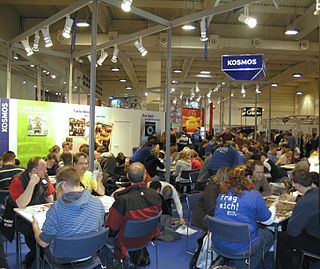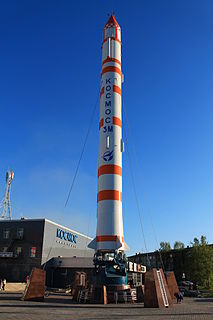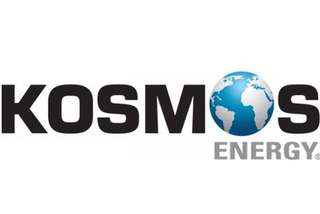
The Soyuz programme is a human spaceflight programme initiated by the Soviet Union in the early 1960s. The Soyuz spacecraft was originally part of a Moon landing project intended to put a Soviet cosmonaut on the Moon. It was the third Soviet human spaceflight programme after the Vostok (1961–1963) and Voskhod (1964–1965) programmes.
Kosmos 27, also known as Zond 3MV-1 No.3 was a space mission intended as a Venus impact probe. The spacecraft was launched by a Molniya 8K78 carrier rocket from Baikonur. The Blok L stage and probe reached Earth orbit successfully, but the attitude control system failed to operate.
Kosmos is a designation given to many satellites operated by the Soviet Union and subsequently Russia. Kosmos 1, the first spacecraft to be given a Kosmos designation, was launched on 16 March 1962.
The Kosmos-3M was a Russian space launch vehicle, member of the Kosmos rocket family. It was a liquid-fueled two-stage launch vehicle, first launched in 1967 and with over 420 successful launches to its name. The Kosmos-3M used UDMH fuel and AK27I oxidizer to lift roughly 1,400 kg (3,100 lb) of payload into orbit. It differed from the earlier Kosmos-3 in its finer control of the second-stage burn, allowing operators to tune the thrust and even channel it through nozzles that helped orient the rocket for the launching of multiple satellites at one time. PO Polyot manufactured these launch vehicles in the Russian city of Omsk for decades. It was originally scheduled to be retired from service in 2011; however, in April 2010 the Commander of the Russian Space Forces confirmed that it would be retired by the end of 2010. One further launch, with Kanopus-ST, was planned; however, this was cancelled in late 2012 as the launch vehicle had exceeded its design life while in storage ahead of the launch.

Kosmos 133, Soyuz 7K-OK No.2, was the first uncrewed test flight of the Soyuz spacecraft, and first mission of the Soyuz programme, as part of the Soviet space programme.

Franckh-Kosmos Verlags-GmbH & Co. is a media publishing house based in Stuttgart, Germany, founded in 1822 by Johann Friedrich Franckh. In the nineteenth century the company published the fairy tales of Wilhelm Hauff as well as works by Wilhelm Waiblinger and Eduard Mörike.
The Kosmos rockets were a series of Soviet and subsequently Russian rockets, derived from the R-12 and R-14 missiles, the best known of which is the Kosmos-3M, which has made over 440 launches. The Kosmos family contained a number of rockets, both carrier rockets and sounding rockets, for orbital and sub-orbital spaceflight respectively. The first variant, the Kosmos-2I, first flew on 27 October 1961. Over 700 Kosmos rockets have been launched overall.

Neos Kosmos is a neighborhood in Athens, Greece.

Kosmos 186 and Kosmos 188 were two uncrewed Soviet Union spacecraft that incorporated a Soyuz programme descent module for landing scientific instruments and test objects.
Kosmos-2I is the designation applied to two Soviet carrier rockets, members of the R-12 Kosmos rocket family, which were used to orbit satellites between 1961 and 1977. They were superseded by the R-14 derived Kosmos-3 and Kosmos-3M.
Strela is a Russian military communications satellite constellation operating in low Earth orbit. These satellites operate as mailboxes ("store-and-forward"): they remember the received messages and then resend them after the scheduled time, or by a command from the Earth. Some sources state the satellites are capable of only three months of active operation, but through coordination with others they can serve for about five years. The satellites are used for transmission of encrypted messages and images.
The Kosmos-1 was a Soviet carrier rocket, derived from the R-14 missile, which was used to orbit satellites in 1964 and 1965. It served as an interim, and was quickly replaced by the Kosmos-3. Eight were flown, and all launches occurred from Site 41/15 at the Baikonur Cosmodrome.

The Kosmos-3 was a Soviet carrier rocket, derived from the R-14 missile, which was used to orbit satellites between 1966 and 1968. It was quickly replaced by the modernised Kosmos-3M. Six were flown, four as orbital carrier rockets, and two on sub-orbital flights. All launches occurred from Site 41/15 at the Baikonur Cosmodrome.

FC Saturn Moscow Oblast was an association football club from Russia founded in 1991 and playing on professional level between 1993 and 2010. Since 2004 it was the farm club of FC Saturn Moscow Oblast. In early 2011, the parent club FC Saturn Moscow Oblast went bankrupt and dropped out of the Russian Premier League due to huge debts. However, Saturn-2 passed the licensing and participated in the Russian Second Division.
Kosmos 1241 was a target satellite which was used by the Soviet Union in the 1980s for tests of anti-satellite weapons as part of the Istrebitel Sputnikov programme. It was launched in 1981, and was itself part of the Dnepropetrovsk Sputnik programme. It was a target for Kosmos 1243 and Kosmos 1258.
Kosmos Airlines is a Russian airline founded in 1995 which specialises in the delivery of cargo to launch sites.

Kosmos Energy is an American upstream oil company founded and based in Dallas, Texas. While previously incorporated in Bermuda, Kosmos has reincorporated in Delaware. The company holds production and development operations offshore Ghana, Equatorial Guinea, and Gulf of Mexico, while holding a development project offshore Mauritania and Senegal, and exploration licenses offshore Namibia, São Tomé and Príncipe and Suriname. It was previously involved in exploration offshore Morocco and Western Sahara. It discovered the Jubilee oil field off the coast of Ghana and the cross-border Tortue gas field offshore Mauritania and Senegal. Kosmos was the focus of a documentary Big Men that followed the company as it worked to establish the Jubilee oil field in Ghana.
Kosmos 154, also known as L-1 No.3P, was a Soviet test spacecraft launched from the Baikonur aboard a Proton-K rocket. It was a prototype Soyuz 7K-L1 launched by Proton. It was an uncrewed precursor to the Zond series.








